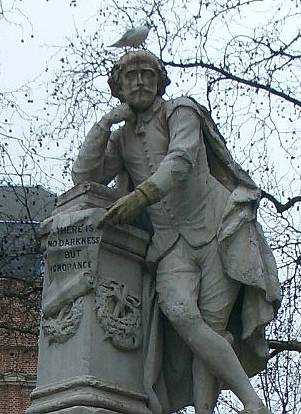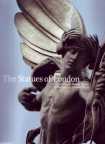[The author of this review, Jacqueline Banerjee, George P. Landow, and other contributors made all the accompanying photographs — none were taken from the book under review — and Landow added the thumbnails linked to larger images. Click on these thumbnails for larger images and additional information, which often includes substantial discussions as well as links to works by the same sculptor or architect.]
Cover of the book under review.
They tower on columns, balustrades, pedestals and plinths, or form elements of monuments and fountains, buildings and bridges. London's statues are everywhere. The PMSA (Public Monuments and Sculpture Association) faces a mammoth task in cataloguing and describing them all. So far its National Recording Project has yielded two volumes on the capital, one covering the city itself (by Philip Ward-Jackson, 2003) and the other covering South London (by Terry Cavanagh, 2007). Two more volumes, on historic Westminster and the South-West London outer boroughs, are in the pipeline. These are doing for sculpture what Nikolaus Pevsner did for architecture in the Buildings of England series — providing an authoritative, indispensable resource for scholars and enthusiasts. Their authors have researched the background of each sculpture in depth, and explain as much as is known about it — how and why it came to be commissioned, its cost and material, the circumstances of the unveiling, its critical reception and its after-history. For the curious, whether Londoners or tourists, there are also pocket-sized handy guides, such as Margaret Baker's Discovering London Statues and Monuments (Shire, most recent edition, 2002), and Andrew Kershman's London's Monuments (Metro Guides, 2007), which offer brief commentaries on all the most significant works. The Statues of London fits neither category well: much more selective, it says comparatively little about the sculptures themselves, and less still about the sculptors, focusing instead on the lives of the subjects; and because of its size and weight this book suits the coffee table rather than the pocket. Nevertheless, it is full of interest, and has some useful contributions to make — especially through Dennis Gilbert's magnificent photographs.


Since there are over 300 sculptures on the façade of the Houses of Parliament alone, a selection of only 80 or so figures (including the occasional bust and bas-relief) really is small. As in the case of the National Portrait Gallery, the main criterion for inclusion was not the quality of the artwork, but the interest of the subjects: "we made the choice primarily on those individuals we consider to be most important and interesting" (Bollus and Asprey 7). Yet much fine artwork is represented here. The earliest statue, dating from about 1395, is one thought to be of Alfred the Great, originally commissioned by Richard II, and now standing in Trinity Church Square, SE1. "[P]robably the oldest outdoor statue in London" (Bollus and Asprey 20), it has great strength and presence, and the details on the belt and the trimming of the cloak are still surprisingly fine. The most recent statues were unveiled only in 2007, and the main selection closes with one of these: Philip Jackson's Bobby Moore at the new Wembley Stadium, arms folded defiantly, one foot planted on the ball.




Sculture mentioned below: Westmacott's Achilles, Brock's Victoria Memorial, Girlbert's Eros, and Frampton's Peter Pan.
Between these two figures, so revealing of their respective ages, the Victorians are well represented, as of course they should be. Royal patronage and public interest ensured that many of the great and good of that era were suitably commemorated, and there was no dearth of talent to draw on for the task. Here, for example, is Sir Richard Westmacott's bravura tribute to Wellington in Hyde Park — a muscular Achilles, flourishing sword and shield dramatically. Also included is Westmacott's more sedate and certainly more fully clothed Charles James Fox, deliberating in Bloomsbury Square with a copy of the Magna Carta at hand. Sir Thomas Brock is represented by the elaborate Victoria Memorial, as well as by his bust of a benevolent-looking Sir Henry Tate outside Brixton Library. Sir Alfred Gilbert's Eros and Sir George Frampton's Peter Pan could hardly have been omitted, but again there are other less celebrated choices: Frampton's rather austere Edith Cavell in St Martin's Place, near Trafalgar Square, for instance. A gazetteer at the end lists a hundred additional works, a handful of which, such as Brock's statue of Sir John Everett Millais from behind the Tate Gallery, also have small illustrations; another addendum turns from mainly freestanding sculpture to identify architectural sculpture on important buildings like the Royal Academy. Some fine sculptors, like Harry Bates and Sir John Steell, appear only in these addenda; unfortunately, others, like Francis Derwent Wood, get no mention at all.


Sir John Betjeman by Martin Jennings. William Hogarth by Jim Mathieson.
Inevitably, given the criterion for selection, there is greater cross-section of subjects than sculptors. Countries as well as ages can be understood by their heroes. Apart from royalty and national leaders, there are cultural icons like St George, sculpted by Charles Hartwell for the Marylebone war-memorial; artists like the Hogarth, whose much-acclaimed statue by Jim Mathieson was installed in Chiswick High Road only a few years ago; and a troupe of writers, musicians, scientists, engineers, explorers and so forth, not forgetting those who, like Lord Shaftesbury and Emmeline Pankhurst, stood in the forefront of social change. Most endearingly British, perhaps, is a figure from our own times, Sir John Betjeman, gazing up in admiration at the glass and iron arch over London's newly restored St Pancras Station. But not all the subjects were "Great Brits," and this too says much. Mikhail Shemyakin's dynamic Peter the Great stands tall, proud and commanding near the dockyards at Deptford where he studied shipbuilding, and Fredda Brilliant's Ghandi sits meditating, often garlanded with fresh flowers, in Tavistock Square — not in the Western clothes he would have worn when studying law near here, but in his trademark dhoti, emblematic of his struggle against the British Raj. Washington, Lincoln and Roosevelt, and four Latin American liberators, testify to our strong links with "the other side of the pond," with the words on Simón Bolívar's plinth reminding us of a time when the nation held its head somewhat higher than it does now: "I am convinced that England alone is capable of protecting the world's precious rights as she is great, glorious and wise," he said (qtd. in Bollus and Asprey 88). The information about these subjects, while avoiding scholarly controversy, is nicely focused and engagingly written, and there is a virtue in juxtaposing the likenesses and stories of these great achievers. It certainly encourages us to join Stephen Spender in thinking "continually of those who were truly great." One of the most interesting parts of the book is a section suggesting a hundred other subjects worthy of commemoration in the capital. These include Charles Darwin, Elizabeth Garrett Anderson and James Clerk Maxwell, and many others to whom the modern world owes an enormous debt.

Shakespeare by Giovanni Fontana (1821-1893), after William Kent and Peter Scheemakers.
But the great attraction of the book, the feature that turns it from a Who's Who into an art-book, is the photography. London's statues seem part of the scenery and are often obscured, if not by trees, buses and goods vehicles, then (like the figure of Shakespeare in Leicester Square) by sheer familiarity. Even when fully visible, they are often comically covered with birds, and in some cases worn by exposure to the elements or by past attempts at chemical cleaning. The more accessible are also scratched with graffiti or otherwise damaged by vandalism. No wonder people rarely stop to appreciate them. Moreover, contrary to what one would expect, they are often hard to photograph. They might stay obligingly still, but their surroundings do not, and light and shade are apt to fall in all the wrong places. Besides, it can be positively dangerous to catch the best view on a narrow, congested street. With one or two exceptions (the memorial to Bazalgette on the Embankment wall, for example, in which the subject's face is partly shaded, admittedly a very difficult subject to photograph successfully), Dennis Gilbert's colour plates are impeccable, his angles different and revealing, and the whole composition often unexpectedly alive. The choice of details too is excellent: a hand grasps a sword, clasps a bible or binoculars, or grips a paintbrush, pen or walking-stick. In one case (the young Mozart by Philip Jackson again), the object is a violin; a full page is devoted to this detail, and it is well worth dwelling on. Elsewhere, a General's spurred boot rests on a broken mortar, and a dead soldier's feet protrude from the greatcoat that covers him (Sir Hamo Thornycroft's General Charles Gordon, and Charles Sargent Jagger's Royal Artillery Memorial, respectively). Best of all perhaps is the double spread partial view of Sir Joseph Boehm's equestrian statue of Wellington at Hyde Park Corner. This rescues the sculpture from its awkward placing: no longer baulked by the trees in front of it, the charger bearing its grim-faced rider suddenly become dynamic and powerful.

"A Conversation with Oscar Wilde by Maggi Hambling
As works of art, then, and seen with Dennis Gilbert's artist's eye, the statues speak for themselves. This branch of sculpture seems less susceptible than most to radical experimentation: compare, say, Philip Jackson's faithfully proportioned and detailed public commissions with his intriguing, often faceless or masked gallery work (see offsite here). Nevertheless, the best statues are still distinctive and adventurous. Eros, thanks to Gilbert's innovatory use of aluminium, and its overall conception — its strength, delicacy and poise — is adventurous in many ways. So is Maggi Hambling's more recent scrawled and sprawling A Convesation with Oscar Wilde. A sort of sculptural version of Felix Topolski's unconventional likenesses, Hambling's version of Wilde is still immediately recognizable. Uncommon people deserve uncommon monuments.
Anyone with an interest in sculpture will enjoy looking through this book, then, and find it inspiring and thought-provoking. But those with more than a passing interest in the art form would be advised to move on to more scholarly studies, with more to say about the statues themselves. For the nineteenth century, Benedict Read's Victorian Sculpture (Yale University Press, 1982), and Susan Beattie's The New Sculpture (Yale University Press, 1983), both frequently cited on this website, come to mind. Note that even where this book seems most useful to students — in its factual information about the statues — Statues of London is not always dependable: for example, it misidentifies one of the busts on the outside of the Royal Institute of Painters in Water Colours, on Piccadilly, as that of William Holman Hunt (1827-1910), when in fact it depicts the very different-looking William Henry Hunt (1790-1864), an early and productive member of the Institute.
Bibliography
Bullus, Claire, and Ronald Asprey. Statues of London. With Photographs by Dennis Gilbert. London &: New York, Merrell, 2009. 256pp. £45.00. ISBN 978-1-8589-4472-2.
Last modified 27 May 2009
